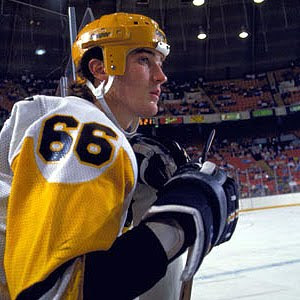Sunday, September 19, 2010
By Gene Collier, Pittsburgh Post-Gazette
http://www.post-gazette.com/sports/?m=1
 The outdated electronic marquee outside Mellon Arena was all black Friday afternoon, towering over a vacant Uptown sidewalk like an unplugged heart monitor 24 hours after the Sports and Exposition Authority had signed the building's death warrant.
The outdated electronic marquee outside Mellon Arena was all black Friday afternoon, towering over a vacant Uptown sidewalk like an unplugged heart monitor 24 hours after the Sports and Exposition Authority had signed the building's death warrant.The merits of that decision are not today's topic, as they are apparently scheduled for legal overtime, or unsudden death, if you will.
This is more one guy's final attempt at locating the old building's place on the fondness meter, which for some reason has always been more difficult for me than it ought to be. I've heard respected national correspondents, particularly hockey writers, rhapsodize about the 49-year-old Civic Arena this week, but I honestly didn't find any of my feelings lurking in their testimony.
I don't think I had anything approaching antipathy for the Igloo, except for some persnickety grouchiness about that nickname. Penguins, after all, do not live in or near igloos, which are primarily a North Pole area structure while Penguins are exclusively a South Pole area phenomenon. Yes, it has a domed shape like an igloo, but igloos do not have retractable roofs, unless perhaps as the headquarters of an evil genius in one of the James Bond films I haven't seen.
Anyway . . .
Will I miss it?
Umm.
Ya mean really miss it?
Ehh . . . no.
Now admittedly, most of the visual arts, including ages of inspired architecture, are generally lost on me, which is probably why I've always thought of the vast exterior of Mellon Arena as something they picked up in the housewares department at Macy's, some kind of giant pressure cooker with a handle, or perhaps the world's largest stainless steel wok.
As to the interior, I'd put Mellon Arena among America's most difficult buildings to navigate, a giant disc of concentric inner circles and half-circles, a labyrinth of narrow concourses and even narrower backstage hallways, an ominous topography of elongated ramps and treacherous stairwells that yawned open without warning for no apparent reason.
You could be walking down the hall talking to someone at one minute, and suddenly you'd be alone, your partner in conversation having fallen down two flights into the Zamboni bay.
Good luck finding him.
In the parts of 28 years I spent there, the press box was in three different locations. If I went to the Penguins locker room 1,000 times, I took approximately 679 different routes, often through the crowd, sometimes via Bigelow Boulevard. For some reason, I could always find the visitors room easier. The chances that I wrote a column on a visiting hockey player because I was not confident I could find the Penguins locker room on deadline, are, in fact, excellent.
New to the city, the first thing I was assigned to cover there was a Spirit press conference, no doubt to trumpet the signing of someone no one in the Tri-State area had ever heard of, least of all me. On the way back to the office, trying to figure out which sport the Spirit played, if any, I wound up on Mount Washington.
One of the first beats I covered for the Post-Gazette was Duquesne basketball, which then called the arena home, in the tortured sense that 650 people sitting around a 17,000-seat facility is in some way homey. The home-court advantage in that era must have been that any five people selected randomly from the 650 had as good a chance to win as the student-athletes available.
 In the early '80s, even if no one was aware of it, Mellon Arena was looking hard at an athletic legacy in which virtually nothing nationally significant happened there. It was true that some quality college basketball got played there. It was true that Larry Holmes defended his heavyweight title there one night in 1981. But Pittsburgh's Mellon Arena could easily have lived its entire life without the average American being able to tell you anything that happened there. Ever.
In the early '80s, even if no one was aware of it, Mellon Arena was looking hard at an athletic legacy in which virtually nothing nationally significant happened there. It was true that some quality college basketball got played there. It was true that Larry Holmes defended his heavyweight title there one night in 1981. But Pittsburgh's Mellon Arena could easily have lived its entire life without the average American being able to tell you anything that happened there. Ever.All that changed the night of Oct. 17, 1984, when Mario Lemieux (pictured at left) began a 20-year career that filled the old barn's legacy with signature highlights that could not be seen regularly in any other building in the world.
Lemieux made the place an American landmark, an address where even though Elvis and the Beatles had signed the guest book, there will never be any doubt whose house it was.
In that regard, we were all privileged to been under the same roof at some point or another, and thus an escapable sadness awaits when the roof finally comes down.
Also, on May 12, 2010, between the first and second periods of the final hockey game ever played there, you could still get a hotdog for $2.50.
I'll miss that.
Gene Collier: gcollier@post-gazette.com or 412-263-1283.
Read more: http://www.post-gazette.com/pg/10262/1088476-150.stm#ixzz0zzCgaXJ4


No comments:
Post a Comment